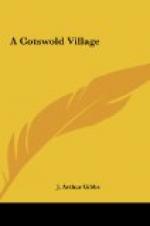Flow on, historic waters, symbolic of all that is good, all that is great—flow on, and do thy glorious work until this world shall cease; bearing thy mighty burden down towards the sea, showing mankind what can be wrought from small beginnings by slow and patient labour day by day.
* * * * *
Even in winter I do not know any scene more pleasing to the eye than the sight of a Cotswold hamlet nestling amid the stately trees in the valley, if you happen to see it on a fine day. And if there has been a period of rainy, sunless weather for a month past, you are probably all the more ready to appreciate the changed appearance which everything wears. If that peaceful, bright aspect had been habitual, you would never have noticed anything remarkable to-day. It is this very changeful nature of our English climate which gives it more than half its charm.
But the great attraction of this country lies in its being one of the few spots now remaining on earth which have not only been made beautiful by God, but in which the hand of man has erected scarcely a building which is not in strict conformity and good taste. One cannot walk through these Cotswold hamlets without noticing that the architecture of the country in past ages, as well as in the present day to a certain degree, shows obedience to some of those divine laws which Ruskin has told us ought to govern all the works of man’s hand.
“The spirit of sacrifice,” “the lamp of truth” are manifest in the ancient churches and manor houses, as well as in the humble farmhouses, cottages, and even the tithe barns of this district. Two thirds of the buildings are old, and, as Ruskin has beautifully expressed it: “The greatest glory of a building is not in its stones, nor in its gold. Its glory is in its age, and in that deep sense of voicefulness, of stern watching, of mysterious sympathy, nay, even of approval or condemnation, which we feel in walls that have long been washed by the passing waves of humanity. It is in their lasting witness against men, in their quiet contrast with the transitional character of all things, in the strength which, through the lapse of seasons and times, and the decline and birth of dynasties, and the changing of the face of the earth, and of the limits of the sea, maintains its sculptured shapeliness for a time insuperable, connects forgotten and following ages with each other, and half constitutes the identity, as it concentrates the sympathy, of nations;—it is in that golden stain of time that we are to look for the real light and colour and preciousness of architecture; and it is not until a building has assumed this character, till it has been entrusted with the fame and hallowed by the deeds of men, till its walls have been witnesses of suffering and its pillars rise out of the shadow of death, that its existence, more lasting as it is than that of the natural objects of the world around it, can be gifted with even so much as these possess of language and of life.”




